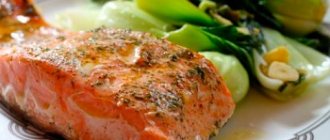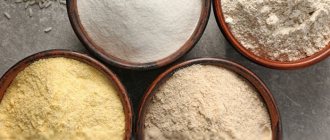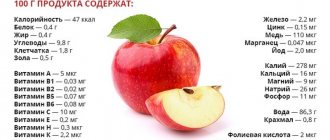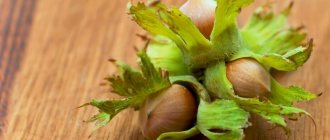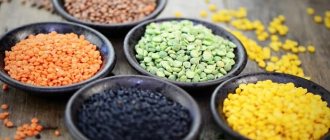Composition and calorie content of cereals
Rice has two dozen botanical species and more than 8 thousand agricultural varieties. Despite this diversity, their chemical composition is almost the same:
- vitamins PP, H and group B – up to 30% of the daily value;
- magnesium, molybdenum, selenium, phosphorus – up to 35%;
- cobalt, copper – up to 60%;
- iron, zinc – up to 15%;
- calcium, sulfur, chlorine, chromium – just over 5%;
- carbohydrates – up to 80%;
- proteins – up to 18%;
- fats – up to 2%;
- dietary fiber – up to 50%;
- essential amino acids – up to 15%;
- pectin – up to 28%.
The calorie content of dry cereal is about 350 kcal. During cooking, it drops to 115 kcal, since the rice absorbs a large amount of liquid. Boiled cereal, along with its calorie content, also loses most of its nutrients. Therefore, it is better to steam it.
Steamed or regular
Steamed rice is good because during processing, some of the beneficial substances from the shell penetrate into the grain. It contains many saccharides, carbohydrates, proteins and lipids. There is pectin, which helps lower cholesterol. Saccharides – in moderation – provide the body with energy for growth. There are thiamine and riboflavin, folic acid and other valuable elements necessary for the health of the body.
Parboiled rice is much healthier than regular rice. It is able to create a gentle film on the walls of the stomach that prevents irritation of the mucous membrane. Thanks to this quality, parboiled rice is included in the diet for people with digestive system problems. It is also useful for patients with diabetes, as it helps the slow absorption of glucose into the blood. Regular rice does not have these properties.
Varieties of rice
The abundance of varieties, on the one hand, makes it difficult to choose, on the other hand, it allows you to find the best option. The answer to the question of how to choose rice depends on what we are going to cook from it.
- Long grain is best suited for crumbly dishes. Pilaf is made from it, added to soups, salads, and used as a side dish.
- Round grain is good for casseroles, puddings, porridges, desserts, and pie fillings. It contains more starch than long-grain, which makes it boil quite well.
- Medium grain is an intermediate option between the two previous types. When cooked, it absorbs a lot of water, softens and is optimal for paella, risotto, sushi, and cereals.
In addition to their shape, rice grains differ in color.
- Brown or brown – the grains are covered with a natural shell rich in nutrients. This rice is recommended for dietary nutrition, since it is almost unprocessed. The vitamins, minerals and fiber necessary for the body are completely preserved. Brown rice takes longer to cook than other varieties.
- White or polished is currently the most popular in the world. The shell is removed, the grains are polished many times, and the cooking time is reduced to 15 minutes. White rice contains significantly fewer nutrients than brown rice.
- Black or wild is a rare, expensive variety. Hard, unprocessed grains contain the maximum amount of nutrients and require pre-soaking. When ready, they have a sweetish, nutty flavor.
- Red – undergoes minor processing without sanding. The pink to burgundy shell retains all valuable vitamins and antioxidants. The grains are easy to prepare, have a delicious aroma and nutty taste.
- Golden or steamed - the grains are peeled from the shells, but are not polished, but are treated with steam. Thanks to this, 80% of the nutrients are stored inside the grain. During cooking, this rice does not stick together and turns white.
Now let's look at which variety is best used in which cases.
About the dangers of boiled rice
What else needs to be said about such a food product as boiled rice? Its benefits - a lot has been said about this. But in what cases should it not be used?
So, it is not recommended for those who have problems with constipation. After all, as you know, rice strengthens you.
It is also necessary to say that refined rice contains a lot of carbohydrates. And this can cause rapid weight gain.
In this case, it is best to eat unpeeled boiled rice, it is more healthy. After all, its husk alone contains almost the complete set of minerals necessary for humans.
Properties of rice and recommendations for consumption
Any of the varieties of this cereal does not contain gluten. Therefore, rice dishes can be included in the menu without fear of developing an allergic reaction. Rice flour serves as an excellent substitute for wheat flour in gluten-free diets. And in Asian countries it is an obligatory component of national cuisine.
Is it possible to lose weight on rice?
Oddly enough, yes. The most effective way to lose weight is to eat black rice. It is low in calories, but high in nutrients and fiber. It saturates easily and quickly, helps improve peristalsis and remove toxins from the body. It is enough to eat boiled black rice and drink herbal teas and water for three days.
If this option seems too “extreme,” you can limit yourself to rice porridge for breakfast. Since black rice does not cook well, you should soak it overnight and boil it without salt in the morning. After such a breakfast you should not drink or eat for 2 hours. The rest of the diet remains normal throughout the day. It is advisable to exclude flour, fried and sweet foods for the best effect.
Digestive problems
Once in the gastrointestinal tract, rice is exposed to hydrochloric acid and has an enveloping effect on the mucous membrane. This property is possessed to a greater extent by purified varieties of rice, from which you can prepare boiled porridge.
For various diseases of the stomach and intestines - such as gastritis, diarrhea, colitis, pancreatitis - rice water is used. It is an excellent natural sorbent and has anti-inflammatory properties. In addition, it effectively fights intoxication due to bacterial and alcohol poisoning.
Contraindications to treatment of the gastrointestinal tract with rice porridge and decoction are sluggish intestines and chronic constipation.
Pregnancy and breastfeeding
For women during pregnancy, rice dishes will help diversify their diet and replenish their supply of vitamins. You shouldn’t give them up just for fear of gaining excess weight or causing constipation. You just need to follow the norm - eat rice 2-3 times a week.
It is better to give preference to red, brown and black rice. Their fiber and dietary fiber give a feeling of fullness and promote regular bowel cleansing. Due to the high energy value, strength is quickly restored, which is especially important in the postpartum period.
Nutrients entering the baby's body through breast milk contribute to its harmonious development and growth. And since rice is a hypoallergenic product, there is no fear of your baby developing an allergic reaction.
Man's health
Red rice contains plant proteins that help build muscle mass. During active physical activity or sports, men should definitely include rice dishes in their diet.
Wild rice contains about 20% of phytosterols necessary for the synthesis of hormones. And their main function is the ability to reduce the level of “bad” cholesterol. This combination of important properties helps maintain the health of the male genital area and prevents the development of atherosclerosis.
Diabetes
Rice has a different glycemic index, depending on the variety. Let's see which one is suitable for diabetics:
- white round grain – 70 units;
- red – 55;
- brown – 38;
- black – 35.
As we can see, in addition to round grain, other varieties can be consumed by people suffering from diabetes. They do not cause sudden spikes in glucose, and in addition, they help the body produce insulin on its own.
Rice on the children's menu
Milk rice porridge, the recipe for which is known to any mother, is one of the first foods. Due to the hypoallergenic properties of the cereal, it can be introduced into the diet of babies starting from six months. Rice soups and cereals are nutritious, satisfying and easily digestible by the children's gastrointestinal tract.
Pediatricians recommend using brown rice for baby food, but not all children like its taste. In this case, you can offer your child steamed one, which has a mild taste and retains beneficial substances.
Cardiovascular diseases
Brown rice varieties, regularly present in the menu, help in the prevention of cardiovascular diseases. Potassium and magnesium stabilize blood pressure, dilate blood vessels and improve peripheral circulation. Thanks to the consumption of rice, “harmful” cholesterol is gradually eliminated from the body, reducing the risk of blood clots and stroke.
Is it possible to eat rice during pregnancy?
The components of rice cereal are indispensable especially for the female body. For ladies who are in an “interesting” position, it is important to study all the products that she consumes. In this way, you can prevent yourself and your baby from various side effects, allergic responses, etc. So, what are the benefits of rice for a pregnant woman?
Let us remember that rice is one of the most popular food products. And no family can do without it. The glory of rice lies in its amazing taste and healthy qualities.
- Considering the fact that 100 grams of ready-made cereal contains only 116 kcal, the product prevents a pregnant woman from gaining excess weight.
- Potassium, magnesium, phosphorus, zinc and selenium help keep teeth, hair, nails and skin in good condition.
- The amino acid lecithin improves brain activity and helps concentrate attention.
- In case of stool disorder, beneficial oligosaccharides inhibit diarrhea due to their enveloping properties.
- Fiber removes harmful breakdown products and waste from the body.
- Phosphorus and calcium take an active part in the formation of the fetal skeleton, its teeth, nails, etc.
- Potassium stimulates blood circulation and prevents blood pressure from rising.
- Doctors strongly recommend consuming brown rice more often, which contains much more fiber and nutrients.
Possible dangers and contraindications
Rice, especially brown rice, has the harmful ability to accumulate arsenic. According to biologists, this process is inevitable, since arsenic is always present in water and soil. However, this does not mean that we should immediately get rid of all our rice stocks. Before cooking, it is enough to thoroughly rinse the cereal and drain the first water after boiling.
I always cook rice not as it is written on the package, but in a large amount of water. Naturally, not all of it is absorbed, and I drain the remainder. Then I wash the finished rice with plenty of boiled water. This method also helps to reduce arsenic content to a minimum.
Rice has few contraindications. These include:
- regular constipation;
- tendency to obesity;
- increased glucose levels (for round-grain varieties).
To avoid health problems, it is enough to eat rice no more than 2-3 times a week. Then the benefits of rice will definitely be disproportionately greater than the harm.
Benefit
The beneficial properties of rice allow it to be used against various health problems. With it you can:
- stabilize the functioning of the gastrointestinal tract;
- strengthen blood vessels and heart;
- cleanse the blood and improve its composition in case of anemia;
- strengthen memory;
- prevent senile pathologies of the brain and psyche;
- get rid of symptoms of intoxication due to food poisoning;
- stop diarrhea;
- strengthen the nervous system due to B vitamins in the composition;
- It is safe to start eating after a long fast;
- get rid of bad breath;
- improve the condition of skin and nails;
- remove excess salt;
- improve the functioning of the muscular system;
- restore normal eating behavior in anorexia.
Rice decoction is a safe remedy for stopping diarrhea. It is used for both adults and very young children. Rice water has moved from folk medicine to traditional medicine, and is therefore used against diarrhea in some children's infectious diseases hospitals.
Rice is included in the diet of many athletes. Its energy value allows you to obtain a sufficient amount of energy for muscle recovery and growth.
Unpolished rice is the leader in the content of nutrients. It has an unusual taste and is rich in microelements.
In the absence of contraindications, moderate consumption of rice is not harmful to health.
Harm to health in people without chronic diseases may include:
- constipation due to overeating rice dishes;
- flatulence due to unpolished rice;
- obesity from overeating white rice.
White rice can be harmful to diabetics because it contains a significant amount of fast carbohydrates. In people with hypersensitivity of the gastrointestinal tract, undercooked grains of rice cause microscopic damage to the mucous membranes.
How to choose and store rice correctly
To purchase high-quality rice grains in the store, you need to know what to look for when choosing.
- Production date and shelf life.
- The cereal in the package is homogeneous and crumbly.
- There should be no traces of insects or mold.
It is better to store in glass or plastic jars for bulk products with lids. Some housewives advise using linen bags after boiling them in a solution of table or sea salt. This will protect the cereal from bugs.
Personally, I prefer to store rice and other grains in glass containers. And I make sure to put an unpeeled clove of garlic in every jar - it never turns anyone on.
How to choose
The choice of rice depends on the options for its further use. Polished long rice is suitable for cooking crumbly porridges. To make rolls, you buy round, unpolished rice, which becomes sticky when cooked. If you are at risk for diabetes, it makes sense to buy brown rice instead of white.
When purchasing, you should pay attention to the packaging - it should contain information about certification and expiration date. The rice should be free of debris and bugs. If these requirements are met, the product is likely to be good.
When choosing rice of a little-known or rare variety, you should know its properties and contraindications in advance.
Contraindications for use
The fruits of tsitsaniya aquatic have no direct contraindications. It is necessary to monitor the dosage of the ingredient and correctly “fit” rice into the daily diet. Excessive consumption of wild rice can cause constipation, sharp stabbing pain in the abdomen, and nausea/vomiting. A small handful of grains (which fits in your palm) per day will be enough to get the necessary nutrients and ensure long-term saturation.
Remember to combine and arrange the product correctly. Serve properly boiled/fried rice with plenty of fiber (mostly vegetables, less often fruits). It is best to consume the crop for breakfast so that its calorie content is converted into energy rather than fat deposits on the body.
More fresh and relevant information about health on our Telegram channel. Subscribe: https://t.me/foodandhealthru
We will be grateful if you use the buttons:
Chemical composition
Nutritional value (per 100 grams of unprocessed grains)
| Calorie content | 357 kcal |
| Squirrels | 14.7 g |
| Fats | 1.08 g |
| Carbohydrates | 68.7 g |
| Water | 7.76 g |
| Alimentary fiber | 6.2 g |
| Ash | 1.53 g |
Vitamin composition (in milligrams per 100 grams of unprocessed grain)
| Beta-carotene (A) | 0,011 |
| Thiamine (B1) | 0,115 |
| Riboflavin (B2) | 0,262 |
| Niacin (B3) | 6,8 |
| Choline (B4) | 35 |
| Pantothenic acid (B5) | 1,074 |
| Pyridoxine (B6) | 0,391 |
| Folic acid (B9) | 0,095 |
| Tocopherol (E) | 0,82 |
| Phylloquinone (K) | 0,0019 |
Nutrient balance (in milligrams per 100 grams of unprocessed grain)
| Macronutrients | |
| Potassium (K) | 427 |
| Calcium (Ca) | 21 |
| Magnesium (Mg) | 177 |
| Sodium (Na) | 7 |
| Phosphorus (P) | 433 |
| Microelements | |
| Iron (Fe) | 1,96 |
| Manganese (Mn) | 1,329 |
| Copper (Cu) | 0,524 |
| Zinc (Zn) | 5,96 |
| Selenium (Se) | 0,0028 |
What are the benefits of wild rice?
Wild rice is very similar to regular white rice. But it is much more expensive, and it also contains much more useful microelements. It is grown in swampy areas. Due to this, it absorbs many vitamins and nutrients.
Wild rice is especially beneficial for athletes because it contains a large amount of protein. For bodybuilders, this is an indispensable cereal. It can be included in your weekly diet to replenish nutrients to your muscles. This causes their rapid growth. At the same time, wild rice is practically free of fats and harmful cholesterol.
This type of cereal differs in that it needs to be prepared somewhat differently. Before cooking, you need to let it sit for about an hour in warm water. This is necessary for the protective peel to soften. If this procedure is not done, the rice will be hard and will not cook completely. After soaking, it will need to be cooked for about an hour.
Use of rice in folk medicine
Most often, rice appears on tables in the form of porridge or a side dish for other dishes. But the medicinal properties of rice are also used in folk medicine - useful decoctions and infusions are prepared from its grains.
Since the properties of the product help free the body from toxins and waste, the benefits and harms of rice cereals are purposefully used to cleanse the body. It is carried out like this:
- white rice is poured with water in the evening and left to infuse in the refrigerator;
- in the morning, drain the water from the container with cereal, scoop up a small amount of raw grains, according to the number of years you have lived, and chew them without drinking water;
- 3 hours after eating rice grains, you can have breakfast with regular foods and drink water or tea.
Cleansing must be carried out for 10 days. You need to take rice at approximately the same time in the morning; it is recommended to have dinner no later than 7 pm. During the cleansing course, you should not drink alcohol, you should also avoid fatty, spicy and smoked foods.
The beneficial properties of raw rice grains will help remove salts and toxins from the body and improve overall well-being. Cleansing with rice can be done regularly, but the break between procedures should be at least 2 months.
Congee
The benefits and harms of rice water are widely known in home medicine. It is prepared like this:
- white peeled rice is washed several times until the water from under it becomes clear and clean;
- pour the cereal with water in a ratio of 1:7 and bring to a boil over medium heat;
- After boiling, reduce the heat to low, then cover with a lid and cook for another half hour.
After 30 minutes, remove the rice from the stove, pour the water from the cereal into a separate container and cool. The decoction contains a high concentration of useful substances and is good for a number of ailments.
